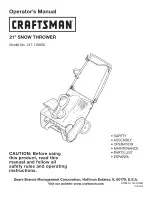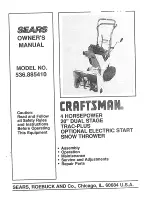
9
51-4180
EQUIPMENT SAFETY PRECAUTIONS
WARNING! KNOW WHERE UTILITIES ARE
Observe overhead electrical and other utility lines. Be sure equipment will clear
them. When digging, call your local utilities for location of buried utility lines, gas,
water, and sewer, as well as any other hazard you may encounter.
WARNING! EXPOSURE TO RESPIRABLE CRYSTALLINE SILICA DUST
ALONG WITH OTHER HAZARDOUS DUSTS MAY CAUSE
SERIOUS OR FATAL RESPIRATORY DISEASE.
It is recommended to use dust suppression, dust collection and if necessary
personal protective equipment during the operation of any attachment that may
cause high levels of dust.
WARNING! REMOVE PAINT BEFORE WELDING OR HEATING
Hazardous fumes/dust can be generated when paint is heated by welding, soldering
or using a torch. Do all work outside or in a well ventilated area and dispose of paint
and solvent properly. Remove paint before welding or heating.
When sanding or grinding paint, avoid breathing the dust. Wear an approved
respirator. If you use solvent or paint stripper, remove stripper with soap and water
before welding. Remove solvent or paint stripper containers and other flammable
material from area. Allow fumes to disperse at least 15 minutes before welding or
heating.
WARNING! END OF LIFE DISPOSAL
At the completion of the useful life of the unit, drain all fluids and dismantle by
separating the different materials (rubber, steel, plastic, etc.). Follow all federal, state
and local regulations for recycling and disposal of the fluid and components.
OPERATING THE SWEEPER
• Do not exceed the lifting capacity of your prime mover.
• Operate only from the operator’s station.
• When traveling on rough terrain, reduce speed to avoid “bouncing” the sweeper.
Loss of steering can result.
• When operating on slopes, drive up and down, not across. Avoid steep hillside
operation, which could cause the prime mover to overturn.
• Reduce speed when driving over rough terrain, on a slope, or turning, to avoid
overturning the vehicle.
• An operator must not use drugs or alcohol, which can change his or her alertness
or coordination. An operator taking prescription or over-the-counter drugs should
seek medical advice on whether or not he or she can safely operate equipment.
• Before exiting the prime mover, lower the attachment to the ground, apply the
brakes, turn off the prime mover’s engine and remove the key.
• Never lift the lowest portion of the attachment plate higher than 5’ above
the ground.
• Do not lock the auxiliary hydraulics of your prime mover in the “ON” position.










































